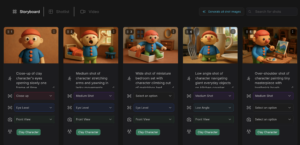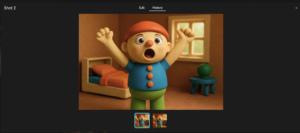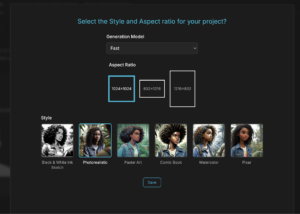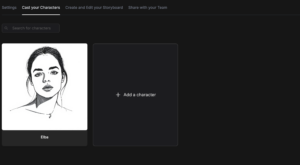Introduction
How to storyboard for stop motion requires meticulous frame-by-frame planning that transforms your creative vision into achievable animation sequences. Unlike other animation techniques, stop motion demands physical precision where every puppet movement, lighting adjustment, and camera position must be planned in advance to avoid costly reshoots and maintain visual consistency throughout your project.
Stop motion animation presents unique challenges that make storyboarding absolutely essential. Each frame requires physical manipulation of puppets, sets, and props, making spontaneous creative decisions expensive and time-consuming. A single mistake in puppet positioning or lighting can ruin hours of careful animation work, forcing animators to restart entire sequences from scratch.
Traditional storyboarding methods often fail to capture the technical precision that stop motion requires. Hand-drawn sketches struggle to communicate exact puppet positions, camera angles, and lighting setups that your animation team needs to execute your creative vision successfully. This communication gap leads to inconsistent animation, wasted production time, and frustrated creative teams.
Modern animators are discovering that AI-powered storyboarding tools can bridge this precision gap, generating detailed visual references that communicate exact technical requirements while maintaining creative flexibility. Shai Creative’s intelligent storyboard generator understands the unique demands of stop motion production and creates professional references that guide your entire animation process.
Ready to streamline your stop motion pre-production and ensure every frame serves your story? Start creating precise animation storyboards with Shai Creative and bring your stop motion vision to life with unprecedented accuracy.
Why Storyboarding Matters for Stop Motion

Stop motion animation operates under constraints that make visual planning more critical than any other animation technique. Each frame requires physical manipulation of tangible objects, making changes expensive and time-consuming once production begins. Unlike digital animation where adjustments can be made quickly, stop motion mistakes often require completely rebuilding sets, repositioning puppets, and recalibrating lighting setups.
The time investment makes thorough planning essential. Professional stop motion productions typically capture only 5-10 seconds of finished animation per day, making every shooting decision precious. Without detailed storyboards, animators waste valuable production time experimenting with compositions, puppet positions, and camera angles that should have been resolved during pre-production.
Physical limitations create additional planning requirements. Puppet armatures have movement restrictions, sets have space constraints, and lighting equipment creates accessibility challenges that must be considered during storyboard development. Visual planning helps identify these physical obstacles before expensive production begins.
Storyboarding also ensures visual consistency across long production schedules. Stop motion projects often span months or years, with different animators working on various sequences. Detailed visual references help maintain consistent character performances, lighting moods, and compositional styles regardless of who animates individual scenes.
The collaborative benefits extend to entire production teams. Set builders, puppet makers, and lighting technicians all require clear visual guidance to create environments and characters that support your creative vision. Professional storyboards communicate these requirements clearly, preventing costly miscommunication between departments.
Quality control becomes manageable when every frame has been planned in advance. Storyboards allow directors to spot potential problems, continuity issues, or technical challenges before physical production begins, when solutions are still affordable and easy to implement.
What Makes a Great Storyboard for Stop Motion

Stop motion storyboards must balance creative storytelling with technical precision that other animation formats don’t require. Each frame needs to communicate not just visual composition, but exact puppet positioning, camera placement, and lighting setups that physical production teams can replicate consistently.
Puppet positioning annotations become crucial for maintaining character consistency across complex animation sequences. Include detailed notes about armature poses, facial expressions, and any props or costume elements that require specific placement. These technical details help animators maintain consistent character performance and avoid continuity errors that plague stop motion productions.
Camera placement specifications help cinematographers achieve consistent framing throughout long animation sequences. Note exact camera heights, distances, and angles that maintain visual continuity when scenes are animated over multiple days or weeks. Include lens choice recommendations that affect depth of field and perspective consistency.
Lighting documentation ensures visual consistency across extended production schedules. Stop motion lighting setups are complex and difficult to recreate precisely, making detailed lighting notes essential for maintaining mood and visual quality. Include specific light positions, intensities, and color temperatures that support your story’s emotional requirements.
Timing considerations unique to stop motion require special attention in storyboard annotations. Note the intended duration of each shot, planned frame rates, and any slow or fast motion effects that require specific animation approaches. This timing information helps animators plan their work efficiently and maintain consistent pacing throughout your project.
Set and prop requirements need detailed documentation to ensure production teams build environments that support your creative vision. Include specific measurements, materials, and construction details that affect how sets will function during animation. Consider accessibility for animators, camera placement, and lighting equipment when planning set designs.
The most effective stop motion storyboards also account for practical production workflows. Plan sequences that can be animated efficiently, consider puppet maintenance requirements, and design shots that work within your studio’s physical limitations.
Traditional vs AI Storyboarding Tools

Shai’s intuitive interface where users can upload a script and generate visual storyboards, complete with scene sequencing, shot duration, and voiceover options — all in one platform.
Traditional stop motion storyboarding relies heavily on detailed hand-drawn illustrations that attempt to capture the technical precision these productions require. While experienced storyboard artists can create detailed references, this approach creates significant bottlenecks for independent animators and small studios operating with limited budgets and tight schedules.
The skill requirements become prohibitive for many talented animators. Creating professional-quality storyboard illustrations requires advanced drawing abilities that many stop motion directors lack, leading to inadequate visual planning or expensive freelance artist costs that strain production budgets.
Technical detail communication presents ongoing challenges with traditional methods. Hand-drawn storyboards struggle to convey precise puppet positions, exact camera placements, and complex lighting setups that stop motion production requires. This technical ambiguity leads to miscommunication between directors and animation teams, resulting in inconsistent visual quality and wasted production time.
Revision cycles become extremely time-consuming when directors need to adjust creative concepts based on technical feedback from puppet makers, set builders, or animation supervisors. Manual storyboard revisions can take days or weeks to complete, delaying entire production schedules and increasing project costs.
Collaboration difficulties arise when multiple team members need to reference and modify visual concepts throughout pre-production. Traditional storyboards exist as static documents that cannot be easily shared, updated, or annotated by different department heads working on related production elements.
Shai Creative’s AI storyboard generator eliminates these traditional limitations while maintaining the technical precision that stop motion requires. Advanced algorithms generate detailed visual concepts that communicate exact positioning, lighting, and compositional requirements to production teams.
Consistency becomes automatic when AI tools generate multiple frames with maintained visual standards, character proportions, and environmental details. This consistency helps stop motion productions maintain visual quality across long animation schedules and multiple animators.
Experience the precision and efficiency of AI-powered stop motion storyboarding and discover how technology can enhance your creative process while meeting technical production requirements.
Step-by-Step: How to Storyboard for Stop Motion
Define Your Story Goal

Begin your stop motion storyboarding process by clearly establishing your animation’s central theme and the specific emotional experience you want audiences to have. Stop motion’s tactile, handcrafted quality creates unique storytelling opportunities that should influence every creative decision from puppet design to camera movement choices.
Consider the distinctive aesthetic qualities that stop motion brings to your story. The medium’s inherent charm works particularly well for whimsical, nostalgic, or intimate narratives that benefit from tangible, handmade visual qualities. Define how these medium-specific characteristics will enhance your story’s emotional impact.
Document your target audience and distribution context. Festival submissions require different approaches than commercial projects, while educational content needs different pacing than entertainment animation. These contextual factors should influence your storyboard complexity and technical requirements.
Establish production constraints early in the planning process. Stop motion productions have unique limitations regarding puppet movement capabilities, set construction possibilities, and animation complexity that must influence your creative vision from the beginning.
Identify Key Scenes or Interactions

Break your story into essential animation sequences that require detailed visual planning. Focus on scenes involving complex puppet interactions, challenging camera movements, or intricate set pieces that demand precise technical execution. Not every moment requires detailed storyboarding, but key sequences benefit from thorough visual development.
Prioritize scenes with multiple character interactions, since puppet positioning and eyeline coordination become critical for believable performances. Plan sequences involving complex prop manipulation, since these elements require careful choreography to maintain visual believability.
Consider the physical demands each scene places on your animation team. Some sequences may require multiple animators working simultaneously, while others need specialized equipment or extended shooting schedules that affect production planning.
Identify scenes that establish important visual motifs, character relationships, or environmental details that must remain consistent throughout your animation. These foundational moments deserve extra storyboard attention to ensure successful execution.
Create Visual Frames
Transform your scene concepts into detailed visual representations that communicate both creative vision and technical requirements. Focus on composition techniques that take advantage of stop motion’s unique visual qualities—depth of field effects, practical lighting, and tangible texture details that digital animation cannot replicate.
AI tools accelerate this technical visualization by generating multiple composition options that maintain consistent puppet proportions, environmental scale, and lighting conditions. Instead of struggling with manual illustration of complex three-dimensional setups, you can quickly explore different visual approaches and select compositions that best serve your narrative goals.
Experiment with camera angles that showcase stop motion’s dimensional qualities. Low angles can emphasize puppet presence and environmental scale, while high angles can reveal intricate set details and spatial relationships between characters and props.
Pay special attention to depth of field planning, since stop motion cameras can create beautiful focus effects that guide audience attention and enhance visual storytelling. Plan foreground, midground, and background elements that work together to create compelling compositions.
Add Detailed Annotations
Stop motion storyboards require comprehensive technical notes that guide your entire production team through complex physical setup requirements. Include specific puppet positioning details—exact arm positions, facial expressions, and any costume or prop elements that require precise placement for continuity.
Document camera technical specifications including lens choices, focus distances, and any special equipment requirements for complex shots. Note required camera movements, whether they need motion control systems, or can be achieved through manual operation.
Add detailed lighting annotations that help your cinematographer recreate consistent setups across extended animation schedules. Include specific light positions, intensities, color temperatures, and any practical lighting elements that must be integrated into sets.
Include timing information that helps animators plan their work efficiently. Note intended shot durations, required frame rates, and any special timing effects that influence animation approaches. This information helps production managers schedule realistic animation quotas.
Document set interaction requirements, noting any special accessibility needs for animators, camera equipment, or lighting setups. Include measurements and construction details that ensure sets function properly during animation.
Review and Collaborate
Implement a structured review process that incorporates feedback from puppet makers, set builders, and animation supervisors who understand the physical realities of stop motion production. Their technical input can identify potential problems and suggest practical solutions before expensive production begins.
Use collaborative tools that allow real-time feedback and maintain version control across multiple revision cycles. When technical team members suggest modifications, you can quickly generate alternative visual approaches that address practical concerns while maintaining creative integrity.
Schedule formal storyboard approval sessions with key stakeholders to ensure creative vision aligns with production capabilities and budget constraints. These meetings prevent expensive creative disputes during animation and establish clear expectations for final visual quality.
Tips for Optimizing Storyboards for Stop Motion
Plan your storyboards with specific puppet capabilities and limitations in mind. Armature designs determine possible poses and movements, while puppet materials affect durability during extended animation sessions. Design shots that showcase your characters’ strengths while avoiding positions that could damage expensive puppets.
Consider set construction requirements during storyboard development. Complex environments may look impressive but become impractical if they don’t allow proper access for animators, cameras, and lighting equipment. Plan sets that balance visual impact with functional production needs.
Integrate continuity planning throughout your storyboard process. Stop motion productions span long periods where consistency becomes challenging to maintain. Plan detailed reference systems for puppet positions, prop placements, and environmental details that help animators maintain visual consistency.
Build flexibility into complex animation sequences by planning coverage options and alternative approaches for challenging shots. If ambitious technical setups prove problematic during production, having backup plans prevents costly production delays.
Plan for puppet maintenance and replacement needs by designing shots that account for wear and tear on expensive character models. Consider which sequences place greatest stress on puppets and plan production schedules that allow time for repairs and replacements.
Common Mistakes to Avoid
Many stop motion directors create overly ambitious storyboards that cannot be executed within their production’s physical and financial limitations. While creative vision matters, practical constraints like puppet capabilities, set construction budgets, and animation complexity must influence your visual planning from the beginning.
Neglecting technical feasibility during storyboard development leads to expensive production problems. Beautiful compositions may prove impossible to achieve with available equipment, puppet limitations, or set access restrictions. Always collaborate with technical team members during storyboard creation to ensure executability.
Under-planning lighting requirements creates consistency problems that plague stop motion productions. Complex lighting setups are difficult to recreate precisely, making detailed lighting documentation essential for maintaining visual quality across extended animation schedules.
Ignoring puppet maintenance considerations during sequence planning can damage expensive characters or cause production delays. Some animation approaches place excessive stress on armatures or costume elements, requiring replacement or repair that disrupts production schedules.
Failing to plan for production logistics creates inefficient animation workflows. Consider animator access, equipment placement, and set modification requirements when designing shots to ensure smooth production processes.
Why Use an AI Storyboard Generator Like Shai
AI-powered storyboarding transforms stop motion pre-production from a time-consuming illustration challenge into a rapid technical planning process. Shai Creative’s AI storyboard generator produces detailed visual concepts that communicate exact technical requirements while maintaining the creative flexibility that stop motion animation demands.
Precision becomes automatic when AI tools generate consistent puppet proportions, environmental scales, and technical details across multiple storyboard frames. This consistency helps stop motion productions maintain visual quality and technical accuracy throughout long animation schedules.
Speed advantages allow directors to explore multiple creative approaches without extensive manual illustration time. Traditional storyboard creation for stop motion can consume weeks of pre-production time, while AI tools generate professional visual references in minutes, allowing more time for creative refinement and technical problem-solving.
Technical communication improves when storyboards clearly show puppet positions, camera placements, and lighting setups that production teams can understand and execute accurately. AI-generated visuals provide clear references that prevent miscommunication between creative and technical departments.
Collaboration capabilities streamline communication between directors, animators, puppet makers, and set builders throughout pre-production. Real-time sharing and instant revisions help maintain creative momentum while incorporating valuable technical feedback from experienced team members.
Cost efficiency delivers significant value for independent stop motion productions operating with limited budgets. AI storyboarding eliminates expensive freelance illustrator costs while producing superior technical detail and faster turnaround times.
Creative exploration becomes more extensive when you can quickly generate and compare multiple visual approaches for complex animation sequences. This creative flexibility helps directors optimize their vision while respecting production constraints.
Join successful stop motion animators using Shai Creative to create detailed storyboards that enhance creative vision while ensuring technical feasibility and production efficiency.
Final Thoughts + Next Steps
Effective storyboarding transforms stop motion production from chaotic improvisation into purposeful animation that achieves creative goals while respecting physical production realities. By implementing thorough visual planning that considers both artistic vision and technical constraints, animators create more compelling stories while avoiding expensive mistakes and production delays.
The key to successful stop motion storyboarding lies in balancing creative ambition with production practicality. AI-powered tools like Shai Creative provide the precision, consistency, and collaborative capabilities that modern stop motion animation demands. Instead of letting technical illustration challenges limit your visual planning, embrace technology that enhances your creative process while ensuring technical accuracy.
Your next stop motion project deserves the clarity, precision, and professional quality that comprehensive storyboarding provides. Don’t let another production suffer from inadequate visual planning, technical miscommunication, or preventable creative problems. Take action today and discover how AI-powered storyboarding can elevate your animation while streamlining your production process.
Start creating professional stop motion storyboards that communicate your unique creative vision clearly and help your entire team bring exceptional animated stories to life with unprecedented technical precision.